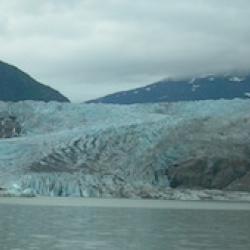Source Institutions
Source Institutions
Add to list Go to activity
Activity link broken? See if it's at the internet archive

In this goopy activity (page 2 of PDF under GPS: Glaciers Activity), learners will model glacial movement with “gak,” a white glue and liquid starch mixture. Each fist-sized gob of gak represents a year’s worth of snow, accumulating to form a “glacier” on a model landscape. Learners will record the gak’s rate of travel as well as make observations of other glacier behaviors. Relates to the linked video, DragonflyTV GPS: Glaciers.
- 5 to 10 minutes
- 10 to 30 minutes
- Over $20 per group of students
- Ages 8 - 14
- Activity, Lesson/Lesson Plan, Model
- English
Quick Guide
Materials List (per group of students)
- a plastic glacier landform model
- gak (white glue, and liquid laundry starch)
- a stopwatch
- a notebook and pencil
Subjects
-
Earth and Space Science
-
Earth Processes
- Weather and Climate
-
Earth Structure
- Oceans and Water
- Atmosphere
-
Earth's History
- Geologic Time
-
Earth Processes
-
Life Sciences
-
Ecology
- Human Impact
-
Ecology
-
Mathematics
-
Data Analysis and Probability
- Data Analysis
- Data Collection
- Data Representation
-
Measurement
- Units of Measurement
- Rate
- Representation
-
Data Analysis and Probability
-
Physical Sciences
-
Motion and Forces
- Gravity
- States of Matter
-
Motion and Forces
-
The Nature of Science
-
The Scientific Process
- About Inquiry
- Conducting Investigations
- Gathering Data
- Formulating Explanations
- Communicating Results
-
The Scientific Process
Informal Categories
- Model Building
- Nature and Environment
Audience
To use this activity, learners need to:
- see
- read
- touch
Learning styles supported:
- Involves hands-on or lab activities
Other
Foreign language versions of this resource:
Components that are part of this resource:
This resource is part of:
Access Rights:
- Free access
By:
Source Collection
- DragonflyTV
Rights:
- All rights reserved, Twin Cities Public Television, Inc., 2007
Funding Source:
- National Science Foundation, 610429
